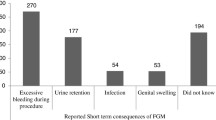Abstract
Objectives
To determine the prevalence and type of female genital mutilation (FGM) among female infants, reasons and attitude of the mothers to the practice.
Design
A cross sectional descriptive study.
Setting
Tertiary centre in Kano Northern Nigeria.
Method
A Pretested questionnaire was administered for mothers of female infants presenting for routine immunization in Aminu Kano Teaching Hospital (AKTH). A total of 250 questionnaires were administered, but only 200 were properly filled and this was used for the analysis.
Main outcome measures
Prevalence and type of FGM, reason for and attitude of mothers towards FGM.
Results
Twenty-six infants had FGM during the period of study, giving a prevalence rate of 13 %. The mean age at cutting was 8 days ± 7.3. The commonest type of FGM was type I accounting for 96.2 % of the cases. Tradition/culture was the commonest reason for mutilation accounting for 73.1 %, other reasons included; religious in 11.5 %, hygienic in 11.5 % and to preserve virginity in 3.8 %. Traditional barbers were the commonest operators in 80.8 % of cases, followed by the nurse/midwife in 15.4 % of cases. The fathers were the main decision makers in 46.2 %, followed by both parents in 26.9 % and grandparents in 15.4 % of the cases. 84 % of mothers were not in support of the practice. Thirteen percent of the clients would circumcise all their daughters. Forty-eight percent of the clients were of the opinion that FGM cause harm to the victims. Four percent of those whose daughters were yet to be circumcised will do so later.
Conclusion
Female genital cutting is still practiced in our environment. Educational enlightenment is fundamental in changing public opinion as well as in offering reasonable alternative to FGM. Campaign against the practice of FGM should be encouraged to eradicate its practice.
Similar content being viewed by others
References
Toubia N (1994) Female circumcision as a public health issue. N Engl J Med 331:712–716
(1997) Female genital mutilation. A joint WHO/UNICEF/UNFRPA statement. World Health Organization, Geneva
Hosken FP (1992) Genital and sexual mutilation of females. The Hosken report. Third review edition. Women International Network News (WINN). 18:4
Odoi AT, Brody SP, Elkins TE (1997) Female genital cutting in rural Ghana, West Africa. Int J Gynaecol Obstet 97:179–180
Taba AH (1979) Female circumcision. In: traditional practices affecting the health of women and children, vol 2. WHO/EMRO Technical Publication, geneva, pp 43–52
Omale AE, Ogunniyi SO, Iliyasu Z (2004) Complications of female genital mutilation in Ile-Ife Nigeria: a ten year review. Nig J Basic Clin Sci 2:50–54
Odoi AT (2005) Female genital mutilation. In: Kwawukume EY, Emuveyan EE (eds) Comprehensive gynaecology in the tropics, 1st edn. Graphic Packaging Limited, Levin, pp 268–278
Laycock HT (1950) Surgical aspects of female circumcision in Somaliland. EAMJ 445–450
Diejomaoh FME, Faal MKB (1981) Adhesion of the labia minora complicating circumcision in the neonatal period in a Nigerian community. Trop Geogr Med 33:135–138
(1997) Female genital mutilation: an overview. World Health Organization, Geneva
Dirie M, Lindmark G (1992) The risk of medical complications after female circumcision. East Afr Med J 69:479–482
El-Dareer A (1983) Complications of female circumcision in the Sudan. Trop Doct 13:131–133
Agugua N, Egwatu V (1982) Female circumcision. Management of urinary complication. J Trop Pediatr 28:248–252
Aziz F (1980) Gynaecologic and obstetric complications of female circumcision. Int J Gynaecol Obstet 17:560–563
Elchalal U, Ben-Ami B, Gillis R, Brzezinski A (1997) Ritualistic female genital mutilation: current Status and future outlook obstet. Gynaecol Surv 52:643–651
Ozumba B (1992) Acquired gynaetresia in eastern Nigeria. Int J Gynaecol Obstet 37:106–109
Version I (1975) Sequence of female circumcision. Trop Doct 5:163–169
De-Silva S (1985) Obstetric Sequence of female circumcision. Eur J Obstet Gynaecol Reprod Biol 32:233–240
Brown Y et al (1989) Female circumcision. Can Nurs 85:19–22
Marleod T (1994) Female genital mutilation. BMJ 9:832
Meniru G (1994) Female genital mutilation. BMJ 9:832
Ali MMO, Alla M (1998) Female genital mutilation as a cause of female infertility. Fertil Steril 70:451
Dorkenoo E, Salla E (1992) Female genital mutilation; proposals for change, vol 5. Minority rights publication, London, pp 44
Elgaali M, Strevens H, Mardh PA (2005) Female genital mutilation an exported medical hazard. Eur J Contracept Reprod Health Care 10:93–97
Al-Hussain TK (2003) Female genital cutting-types, motives and perineal damage in labouring Egyptian women. Med princ pract 123–128
Abubakar I, Iliyasu Z, Kabiru M, Uzoho CC, AbdulKadir MB (2004) Knowledge, attitude and practice of female genital cutting among antenatal patients in Aminu Kano Teaching Hospital. Kano Niger J Med 13:254–258
Mandara MU (2004) Female genital mutilation in Nigeria. Int J Gynecol Obstet 84:291–298
(2006) Female genital mutilation (fact sheet no. 241), WHO, Geneva
Gregory JB, Steven SJ, Christopher PP, Neville JT (2000) Circumcision of healthy boys: criminal assault? J Law Med 7:301
El-Defrawi MH, Lofty G, Dandash KF, Refaat AH, Eyada M (2001) Female genital mutilation and its psychosexual impact. J Sex Marital Ther 27:465–473
Elnashar A, Abdelhady R (2007) The impact of female genital cutting on health of a newly married women. Int J Gynaecol Obstet 97(238):44
Mohammad AT, Mohsen AG, Mahmoud NA, Mostafa A, Esmat M, Mona S (2008) Prevalence of female genital cutting among Egyptian girls. Bull World Health Organ 86:269–274
FIGO Ethical Committee Resolution On FGM. 1994. http://www.figo.org/projects/general assembly-resolution
Author information
Authors and Affiliations
Corresponding author
Rights and permissions
About this article
Cite this article
Garba, I.D., Muhammed, Z., Abubakar, I.S. et al. Prevalence of female genital mutilation among female infants in Kano, Northern Nigeria. Arch Gynecol Obstet 286, 423–428 (2012). https://doi.org/10.1007/s00404-012-2312-8
Received:
Accepted:
Published:
Issue Date:
DOI: https://doi.org/10.1007/s00404-012-2312-8



